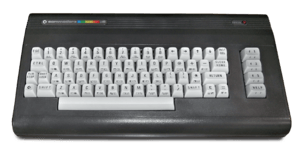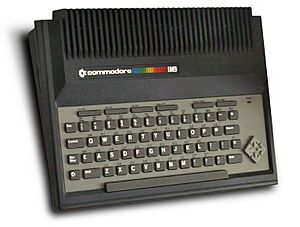Commodore 16 facts for kids
 |
|
| Type | Home computer |
|---|---|
| Release date | 1984 |
| Media | ROM Cartridge, Cassette tape |
| Operating system | Commodore BASIC 3.5 |
| CPU | MOS Technology 7501 or 8501 @ 0.89 MHz or 1.76 MHz |
| Memory | 16 KB RAM + 32 KB ROM |
| Display | 320x200, 320x160 (with 5 lines of text), 160x200, 160x160 (with 5 lines of text) |
| Graphics | TED (320 × 200, 121 colors) |
| Sound | TED (2 channels, 4 octaves + white noise) |
| Input | Keyboard (66 keys, 4 function keys, 4 cursor keys), Joystick |
| Dimensions | 40.7 x 20.4 x 7.7cm |
The Commodore 16 was a home computer made by a company called Commodore International. It came out in 1984. This computer was meant to be a simple, affordable computer for beginners. It was designed to replace an older computer called the VIC-20.
There was also a smaller, cheaper version of the Commodore 16. It was called the Commodore 116 and was only sold in Europe. While the Commodore 16 wasn't very popular in the US, it did quite well in some parts of Europe and in Mexico.
What was the Commodore 16?
The Commodore 16 was part of a new series of computers. These computers used a special chip called the TED. This chip helped with graphics and sound. The Commodore 16 had 16 kilobytes (KB) of RAM. RAM is like the computer's short-term memory. It also had 32 KB of ROM, which is where the computer's basic instructions were stored.
You could connect the Commodore 16 to a TV. It showed graphics in 121 different colors! This was pretty good for computers at that time. You could play games or do simple tasks on it.
Why was it made?
Commodore wanted to make a computer that was even cheaper than their very popular Commodore 64. They thought people would want a simple, low-cost computer. The Commodore 16 was part of a plan to sell millions of these new, affordable machines.
How well did it sell?
The Commodore 16 didn't sell well in the US. It was stopped being sold there within a year. However, it was quite popular in Europe. Many people bought it there to play games. In fact, most of the games made for the C16 came from European developers. It also sold well in Mexico.
One reason it didn't do well in the US was that it couldn't use the same software as the more popular Commodore 64. This meant there weren't as many games or programs available for it. In total, about 1 million computers from this series (including the C16, C116, and Plus/4) were sold worldwide. The C16 and C116 made up about 60% of those sales.
Images for kids
See also
 In Spanish: Commodore 16 para niños
In Spanish: Commodore 16 para niños





